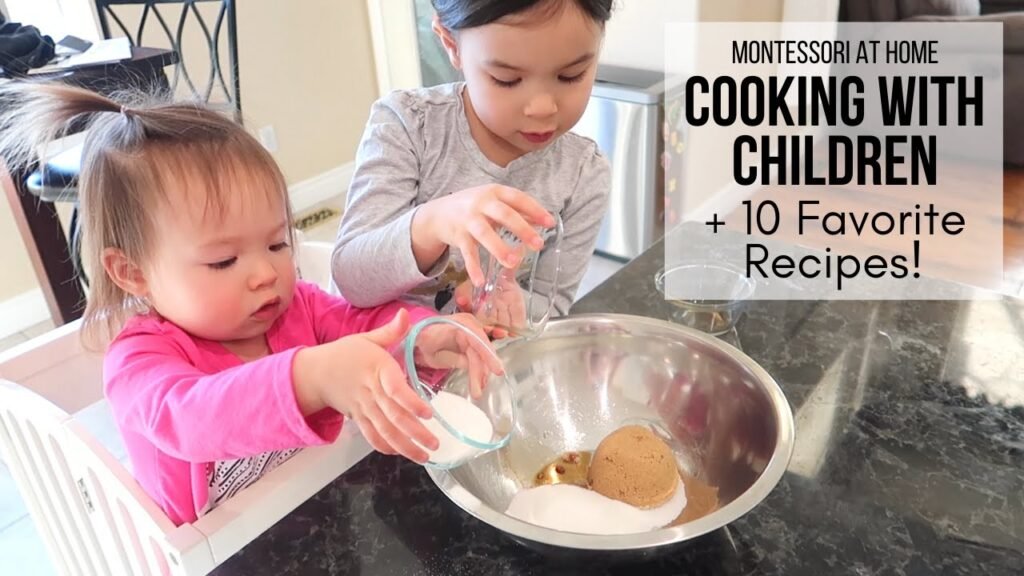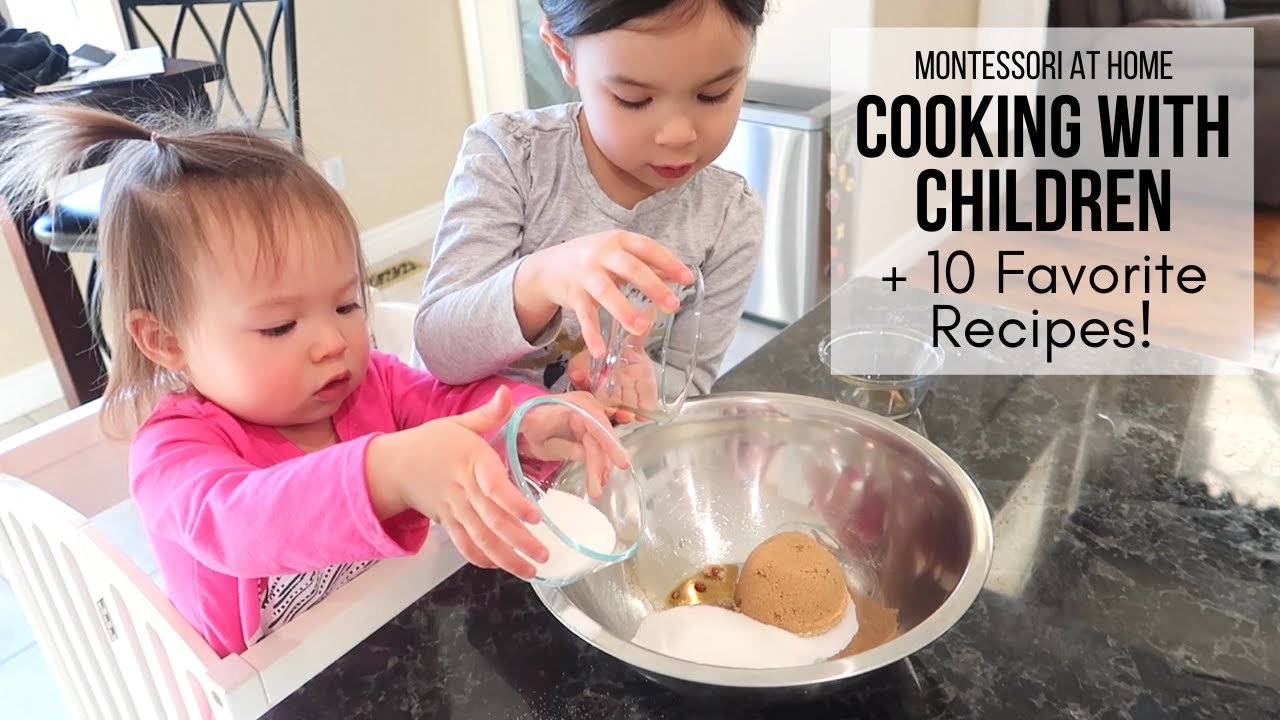Hi there! If you’re looking for some fun and educational activities to do with your little ones at home, you’ve come to the right place! In this article, we’ll be talking all about Montessori at home: Cooking with children. Ashley, a mom of two girls, Kylie and Mia, will be sharing her tips on cooking with young children in a Montessori environment. She’ll be discussing the importance of child-sized tools in the kitchen and how children can benefit from cooking activities even without them.
Ashley will also be sharing 10 of her favorite recipes to cook with toddlers and preschoolers in your Montessori home. From simple scrambled eggs to more creative dishes, these recipes are not only delicious but also adaptable for a wide range of dietary needs. So get ready to roll up your sleeves, get messy, and create some lasting memories with your little ones in the kitchen!
Introduction
Overview of Montessori at home: Cooking with children
In this article, we will explore the world of Montessori cooking in a family setting. Ashley, a mom of two girls, Kylie and Mia, will share her insights and tips on engaging young children in the kitchen using Montessori principles.
Benefits of Cooking with Children
Development of fine motor skills
Cooking with children involves tasks that require precise movements and coordination, thus aiding in the development of fine motor skills. Activities such as whisking, pouring, and mixing help children refine their hand-eye coordination and dexterity.
Enhancement of independence and confidence
By involving children in cooking activities, they learn to take on responsibilities, make decisions, and work independently. This boosts their self-esteem and confidence as they see themselves contributing to the family and successfully completing tasks.
Learning about nutrition and healthy eating habits
Cooking with children provides an excellent opportunity to educate them about nutrition and healthy eating habits. By involving them in meal preparation, children become more aware of the ingredients used in cooking and develop a better understanding of balanced diets.
Montessori Approach to Cooking
Child-sized tools and equipment for kitchen activities
In a Montessori environment, it is ideal to provide children with child-sized tools and equipment for kitchen activities. These scaled-down utensils, such as mini whisks, mixing bowls, and cutting boards, enable children to feel confident and successful in the kitchen, promoting independence and autonomy.
Encouraging autonomy and decision-making in the kitchen
Montessori principles emphasize allowing children to make choices and decisions in their daily activities. In the kitchen, this translates to giving children the freedom to select recipes, choose ingredients, and participate in meal planning. Encouraging autonomy fosters a sense of ownership and responsibility in children.
Focus on practical life skills development
Cooking with children aligns with the Montessori focus on practical life skills. By engaging children in kitchen activities, parents can nurture essential life skills such as organization, time management, and problem-solving. Cooking becomes a valuable learning experience that enhances children’s overall development.

Recommended Recipes
Simple and nutritious breakfast recipes
Start your day with simple scrambled eggs and toast or indulge in homemade yogurt parfaits with fresh fruits and granola. These quick and healthy breakfast options are perfect for busy mornings and involve minimal preparation.
Fun and easy snack ideas
For snack time, try creating fruit kabobs with yogurt dip or preparing mini vegetable quesadillas. These colorful and flavorful snacks are not only delicious but also a great way to incorporate fresh produce into children’s diets.
Hearty and healthy dinner options
End the day with hearty dishes like baked chicken tenders with sweet potato fries or vegetable stir-fry with rice. These satisfying meals are nutritious, balanced, and easy to prepare, making them ideal for family dinners.
Tips for Cooking with Young Children
Setting up a safe and organized cooking environment
Prioritize safety by ensuring a clean and organized cooking space. Remove any hazardous items, have a step stool or learning tower for children to safely reach countertops, and teach them basic kitchen safety rules to prevent accidents.
Involving children in meal planning and grocery shopping
Engage children in meal planning by discussing recipe options and letting them choose ingredients at the grocery store. This fosters decision-making skills, encourages healthy food choices, and develops their understanding of meal preparation.
Encouraging hands-on participation in meal preparation
Allow children to actively participate in meal preparation by assigning age-appropriate tasks such as mixing, stirring, peeling, and garnishing. Encourage them to explore different cooking techniques and engage their senses in the culinary experience.
Age-Appropriate Tasks for Children
Basic tasks for toddlers (e.g., pouring, mixing)
Toddlers can start with simple tasks like pouring pre-measured ingredients into bowls, mixing ingredients together, and tearing soft herbs or leafy greens. These activities introduce them to kitchen tasks and develop their coordination skills.
Intermediate tasks for preschoolers (e.g., peeling, slicing)
Preschoolers can advance to tasks like peeling fruits and vegetables, using child-safe knives for slicing soft foods, and assembling ingredients for recipes. These activities enhance their independence and confidence in the kitchen.
Advanced tasks for school-age children (e.g., measuring, following recipes)
School-age children can handle more complex tasks such as measuring ingredients, following recipe instructions independently, and assisting in cooking on stovetops or ovens. These tasks promote their ability to follow directions and hone their culinary skills.
Ashley’s Recommended Kitchen Tools
Child-sized utensils (e.g., knives, spatulas)
Invest in child-sized kitchen utensils such as knives, spatulas, measuring cups, and mixing bowls to empower children to engage in cooking activities safely and effectively.
Step stool or learning tower for safe access to the countertop
Provide children with a secure step stool or learning tower to access countertops and cooking surfaces at their level. This ensures their safety and encourages their involvement in kitchen tasks.
Easy-to-use kitchen gadgets for children
Consider incorporating child-friendly kitchen gadgets such as cookie cutters, egg separators, and vegetable spiralizers to make cooking more interactive and enjoyable for children. These tools can inspire creativity and exploration in the kitchen.
Additional Resources
Video by Hapa Family demonstrating cooking with children
Explore the Hapa Family’s video on cooking with children to gain inspiration and practical tips for engaging young chefs in the kitchen. Witness the joy and learning that comes from cooking together as a family.
Ashley’s Amazon storefront with recommended child-sized kitchen tools
Visit Ashley’s Amazon storefront to discover a curated selection of child-sized kitchen tools and equipment for engaging children in cooking activities. Find tools that are safe, durable, and designed for children’s use in the kitchen.
Instagram handle for more cooking inspiration: @hapafamilyvlog
Follow @hapafamilyvlog on Instagram for additional cooking inspiration, recipe ideas, and behind-the-scenes glimpses of cooking adventures with children. Join a community of families passionate about teaching children essential life skills through cooking.
Conclusion
Empowering children in the kitchen through Montessori principles can foster a lifelong love of cooking and healthy eating habits
Cooking with children in a Montessori environment offers numerous benefits, from enhancing fine motor skills and independence to teaching valuable life skills and promoting healthy eating habits. By following the Montessori approach to cooking, parents can create meaningful experiences for their children and instill a love for cooking that lasts a lifetime. Encourage your child to explore the world of cooking, experiment with new flavors, and embrace the joy of preparing meals together as a family. Happy cooking!

